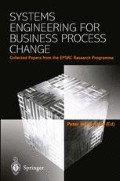Abstract
Although business performance has long been theoretically hypothesised to be dependent on the level of underlying information technology capability, there is a distinct lack of empirical studies to support this claim. In this chapter we discuss preliminary results of ongoing research into the knock-on effects of computer network support to business process performance indicators. Based on a real-life case study of business process change, we develop simulation models that depict operations at three different levels of abstraction (business processes, information system applications, and computer network support). Experiments with different levels of network utilisation generated by increased business workload provide empirical support to the hypothesis that IT capability can be a critical enabler (but equally a critical disabler as well) of business performance improvements.
Access this chapter
Tax calculation will be finalised at checkout
Purchases are for personal use only
Preview
Unable to display preview. Download preview PDF.
References
Baily, M.N. and Chakrabarti, A. (1988). Innovation and the Productivity Crisis. Brookings Institution, Washington, DC.
Bakos, Y. (1998). The emerging role of electronic marketplaces on the Internet. Communications of the ACM, 41(8), 35–42.
Brynjolfsson, E. (1993). The Productivity Paradox of Information Technology. Communications of the ACM, 36(12), 67–77.
Business Week (1987). Office automation: making it pay off. Business Week, 12,134–146.
Curtis, W, Kellner, M.I. and Over, J. (1992). Process modelling. Communications of the ACM, 35(9), 75–90.
Davenport, T.H. (1993). Process Innovation: Reengineering Work Through Information Technology, Harvard Business School Press, Boston, MA.
Davenport, T.H. and Short, J.E. (1990). The new industrial engineering: information technology and business process redesign. Sloan Management Review, 31(4), 11–27.
Earl, M.J. (1994). The new and the old of business process redesign. Journal of Strategic Information Systems, 3(1), 5–22.
Farbey, B., Land, F. and Targett, D. (1993). How to Assess your IT Investment: A Study of Methods and Practice, Butterworth-Heinemann, Oxford.
Fielder, K.D., Grover, V. and Teng, J.T.C. (1995). An empirical study of information technology enabled business process redesign and corporate competitive strategy. European Journal of Information Systems, 4(1), 17–30.
Fuglseth,A.M. and Gronhaug, K. (1997). IT-enabled redesign of complex and dynamic business processes: the case of bank credit evaluation. Omega, 25(1), 93–106.
Galliers, R.D. (1993). Towards a flexible information architecture: integrating business strategies, information systems strategies, and business process redesign. Journal of Information Systems, 3(3), 199–213.
Giaglis, G.M., Paul, R.J. and O’Keefe, R.M. (1999a). Combining business and network simulation models for IT investment evaluation. In Proceedings of the 32nd Hawaiian International Conference on System Sciences, Hawaii, January. IEEE Computer Society, Los Alamitos, CA.
Giaglis, G.M., Paul, R.J. and Hlupic, V. (1999b). Integrating simulation in organizational design studies. International Journal of Information Management, 19(3), 219–236.
Giaglis, G.M., Paul, R.J. and Doukidis, G.I. (1999c). Dynamic modeling to assess the business value of electronic commerce. International Journal of Electronic Commerce, 3(3), 35–51.
Grover, V., Fielder, K.D. and Teng, J.T.C. (1994). Exploring the success of information technology enabled business process reengineering. IEEE Transactions on Engineering Management, 41(3), 276–284.
Hammer, M. and Champy, J. (1993). Reengineering the Corporation: A Manifesto for Business Revolution. Harper Collins, New York.
Kalakota, R. and Whinston, A. (1996). Frontiers of Electronic Commerce. Addison-Wesley, Reading, MA.
Law, A.M. and Kelton, D.W. (1991). Simulation Modelling and Analysis (2nd edn). McGraw-Hill, New York.
MacArthur, P.J., Crosslin, R.L. and Warren, J.R. (1994). A strategy for evaluating alternative information system designs for business process reengineering. International Journal of Information Management, 14(4), 237–251.
Meel, J.W. van, Bots, P.W.G. and Sol, H.G. (1994). Towards a research framework for business engineering. IFIP Transactions A: Computer Science and Technology, 54, 581–592.
Meel, J.W. van and Sol, H.G. (1996). Business engineering: dynamic modeling instruments for a dynamic world. Simulation and Gaming, 27(4), 440–461.
Ould, M.A. (1995). Business Processes: Modelling and Analysis for Re-engineering and Improvement. Wiley, Chichester, UK.
Porter, M. (1985). Competitive Advantage: Creating and Sustaining Superior Performance. Free Press, New York.
Raymond, L., Pare, G. and Bergeron, F. (1995). Matching information technology and organisational structure: an empirical study with implications for performance. European Journal of Information Systems, 4(1), 3–16.
Roach, S.S. (1991). Services under siege: the restructuring imperative. Harvard Business Review, 69(5), 83–91.
Sauer, C.H. and MacNair, E.A. (1983). Simulation of Computer Communication Systems. Prentice Hall, Englewood Cliffs, NJ.
Scott-Morton, M.S. (ed.) (1991). The Corporation of the 1990s: Information Technology and Organisational Transformation. Oxford University Press, New York.
Teufel, S. and Teufel, B. (1995). Bridging information technology and business: some modelling aspects. SIGOIS Bulletin, 16(1), 13–17.
Willcocks, L. (1992). IT evaluation: managing the catch-22. European Management Journal, 10(2), 220–229.
Editor information
Editors and Affiliations
Rights and permissions
Copyright information
© 2000 Springer-Verlag London
About this chapter
Cite this chapter
Eatock, J., Giaglis, G.M., Paul, R.J., Serrano, A. (2000). The Implications of Information Technology Infrastructure Capabilities for Business Process Change Success. In: Henderson, P. (eds) Systems Engineering for Business Process Change. Springer, London. https://doi.org/10.1007/978-1-4471-0457-5_11
Download citation
DOI: https://doi.org/10.1007/978-1-4471-0457-5_11
Publisher Name: Springer, London
Print ISBN: 978-1-4471-1146-7
Online ISBN: 978-1-4471-0457-5
eBook Packages: Springer Book Archive

